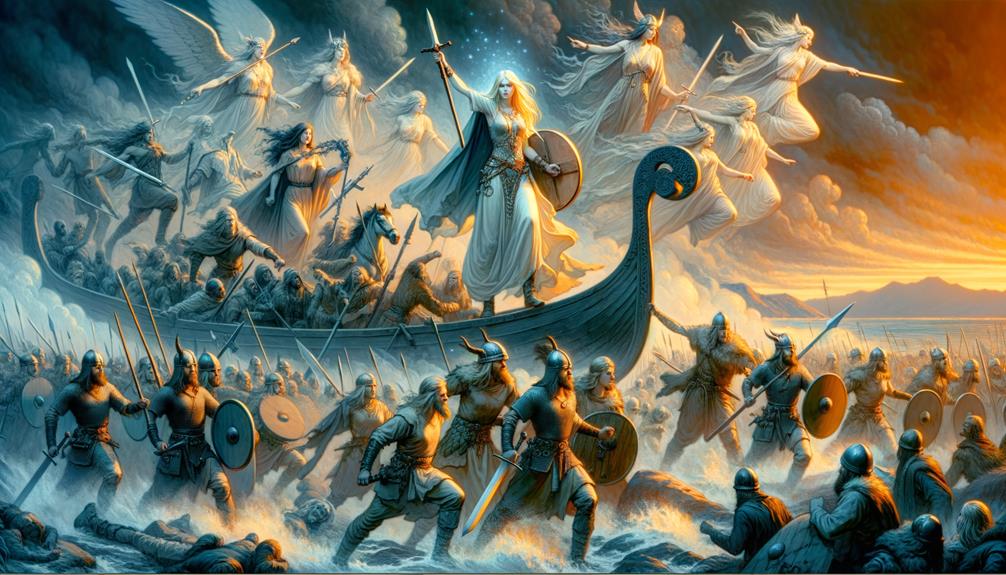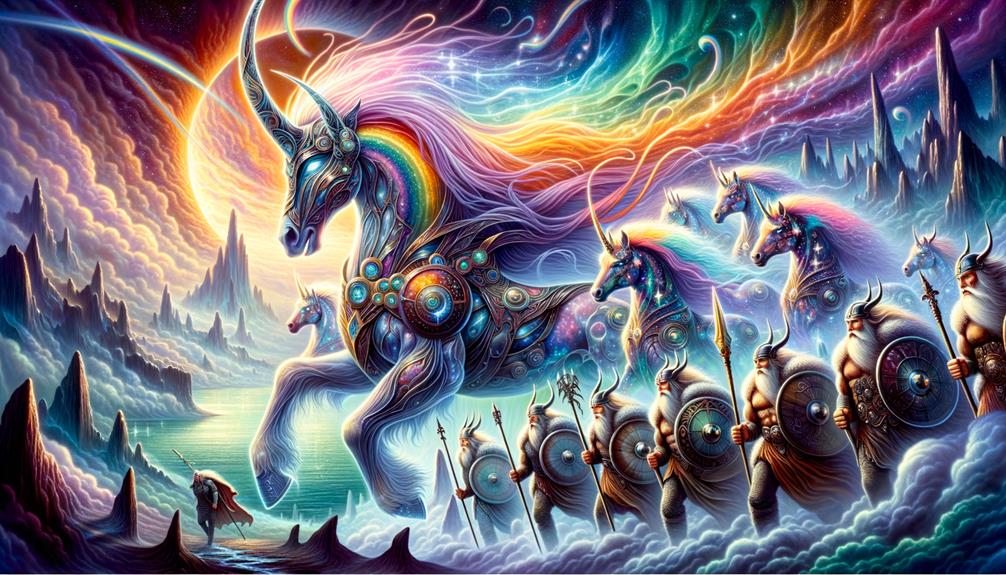You might think Valkyries are just figments from old Norse tales, but I see them as deep reflections of that society’s values and ideals. Being a researcher, I’ve grown to respect how these warrior women, who chose the most courageous dead soldiers for a celebrated afterlife, echo the Norse focus on bravery and honour in combat. These Valkyries have multifaceted roles in folklore, acting as omens of death and guides to eternal glory, and they give us fascinating insight into how the Norse perceived death and what comes after. But why, you may wonder, is the ancient Norse view of death relevant to us now? As we dig deeper, we’ll find traces of these myths in our own ideas about war, bravery, and the female divine.
Origin and Evolution of Valkyries

Let’s talk about the origins and transformation of Valkyries. These awe-inspiring ladies, famous in Norse mythology, started off as rather grim figures, allegedly feasting on the deceased. Over time, they morphed into fearless messengers and fighters serving Odin, their god. As female spirits, they were initially both terrifying and respected, with their names often appearing in Old Norse literature and lists of Valkyrie names, acting as symbols in Pagan culture.
If we look deeper into their transformation, it seems the image of the Valkyrie in Norse mythology altered significantly. They changed from spine-chilling death spirits to brave and honorable warriors, embodying courage and bravery. This change might have been influenced by the portrayal of Celtic heroines or Viking shieldmaidens, both known as figures of strength and fearlessness.
The role of Valkyries in the afterlife, according to Norse mythology, was crucial. They were the chosen twelve Valkyries who decided which warriors were worthy of entering Valhalla, Fólkvangr, or the domain of Hel. They had the power to decide who survived and who perished in battle, a testament to their vital role in the Norse pantheon.
Valkyries’ Role in Battle Outcome

Valkyries play a critical role not only in the afterlife but also in the heat of battle. Their decisions can turn the tide of wars and seal the destiny of warriors. These mythical women, known as the ‘choosers of the slain,’ have a major say in who survives and who falls in combat. They fly over the battlefield, picking the bravest of fallen warriors to accompany Odin to Valhalla.
Far from just being silent spectators, Valkyries actively shape the outcomes of conflicts and thus the narrative of Norse history. Let’s talk more about their roles:
| Aspect | Description | Impact |
|---|---|---|
| Decisions in Battle | Valkyries decide who lives or dies | They have a direct effect on war results |
| Total Number of Valkyries | The believed number of Valkyries | They maintain fairness and balance |
| Selection of Warriors | They choose fallen warriors for Valhalla | They ensure only the bravest make it to the afterlife |
| Messenger Role | They act as Odin’s messengers | They serve as a link between gods and humans |
| Symbol of Bravery | They are associated with courage | They inspire warriors to fight fearlessly |
In this way, Valkyries are seen as powerful entities, weaving together destiny and honor, and steering the narratives of many Norse stories.
Valkyries in Afterlife Realms

When you look at Norse mythology, you can’t miss the part played by the Valkyries. Not only do they have a presence in battles, but they also have a place in the afterlife, guiding fallen heroes to their final resting places. The History Encyclopedia tells us that the Valkyries take the souls of these warriors to their everlasting residences. Two of the most majestic of these are Valhalla, also known as the (Hall of the Slain), and Fólkvangr, a meadow that belongs to the goddess Freyja.
The Prose Edda, a key source of Norse tales, tells us that each of these two places houses half of the chosen warriors. Both are seen as places of great honor in Norse legends. Ellis Davidson, a well-respected scholar, has underlined the crucial part the Valkyries play in deciding who is deserving of such respect, linking them with courage and carnage.
But the well-known figures of Norse mythology are not just found in these places. There’s also Hel’s territory for those not selected by the Valkyries, and a separate place governed by Ran for those who lose their lives at sea. The Ride of the Valkyries, a well-known piece of music, depicts them as heavenly guides to the afterlife, further solidifying their place in our shared knowledge.
Notable Valkyries in Norse Mythology
Let’s chat about some standout Valkyries who take center stage in Norse mythology. One key figure that comes to mind is Sigrún, a Valkyrie linked to the hero Helgi. As depicted in the Poetic Edda, Sigrún is a force to reckon with, a formidable winged woman who decides the fate of warriors in battle before guiding their souls to the afterlife.
Next up, we have Hilda Roderick, another remarkable Valkyrie. Her tales hailing from the Viking Age are teeming with vivid images of warriors mid-combat. Often, she’s illustrated on a winged horse, personifying the Valkyrie’s dual identity as both a warrior and a spiritual guide for those who’ve fallen. Her narrative is a striking testament to the vital role the Valkyries played during this turbulent era in Norse history.
These Valkyries, along with others, underscore the significant impact these winged women had on the Viking Age’s cultural and religious fabric. They performed the divine duties for warriors destined to die in battle, managing their transition into the afterlife. Their narratives offer a captivating glimpse into the spiritual convictions and societal norms of the Norse people.
Valkyries’ Influence in Popular Culture

Valkyries are powerful female symbols that have made their way into various types of art and media, changing how we view strong women in literature, movies, and modern fantasy. These legendary figures are pretty big deals in popular culture, helping to shape our ideas of women warriors who fight shoulder to shoulder with men.
Take Richard Wagner’s opera ‘Der Ring des Nibelungen,’ for example. Valkyries are central to the narrative. The second opera in the series, ‘Die Walküre,’ is named after these magical beings and includes the well-known ‘Ride of the Valkyries’.
So, let’s boil down the influence of Valkyries in popular culture into three main points:
- They’re shown as intense warriors who determine who lives and dies, which mirrors a trend towards stronger female characters in literature and movies.
- They’re often depicted as having romantic relationships, like the hero Sigurd, which adds layers and intricacy to their personas.
- The depiction of a Valkyrie encircled by a ring of fire, just like in Wagner’s opera, has become a standout symbol, manifesting their ties to the divine and otherworldly forces.
Frequently Asked Questions
Who Are the 13 Valkyries?
Hmmm, I’m not entirely certain about the 13 individuals you’re bringing up, as I’d need a bit more information to pinpoint exactly. You see, the number 13 pops up in a whole bunch of traditions, but without additional details, it’s challenging to give you a specific answer.
Was Freya a Valkyrie?
So, was Freya a Valkyrie? Actually, no. Freya was much more than that in Norse mythology. She was a highly respected goddess who was linked with love, beauty, and fertility. She had her own place, known as Fólkvangr, which was different from Valhalla. This distinction further sets her apart from the Valkyries.
Who Is the Most Famous Valkyrie?
So, you’re curious to know who tops the chart when it comes to the most famous Valkyrie, right? Well, from what I’ve read and seen, that title goes to Brynhild. Her story is the heart of many epic tales, especially the Volsunga Saga. There, her star-crossed romance with the legendary hero Sigurd really catches people’s attention. She’s not just a character – she’s a sensation in her own right.
Are Valkyries Daughters of Odin?
So, you’re asking if Valkyries are Odin’s daughters? Well, they’re not. Instead, they’re more like his helpers, with the critical job of picking out the fallen warriors who get to go to Valhalla. Interestingly, some of them are said to have human parents, which hints at a possible human origin. This makes them a significant part of Norse beliefs about what happens after death.

